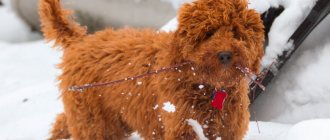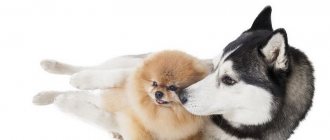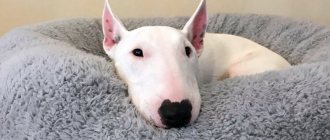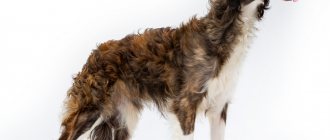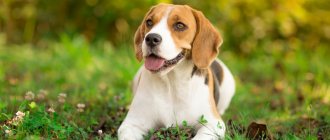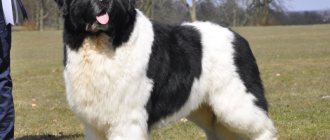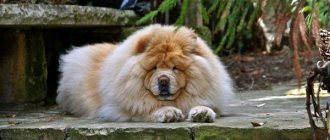What breed of dog is associated with Japan? Among them, it is worth highlighting Shikoku. In Europe, these dogs are not very popular, however, it is worth getting to know the representatives of this breed, because these are magnificent Japanese primary dogs that have a considerable circle of fans on the Asian continent. Shikoku, one of the six Japanese Spitz breeds. This is not a dog for everyone.
Origin of the Shikoku breed
Shikoku dogs were known to the inhabitants of Japan already in ancient times, and were closely associated with hunting. The game had no chance if any of the hunters took this breed with them. Shikoku, even in its homeland, is a rare species - the local population is only 1000 dogs. Outside of Japan, this breed is completely unique, since a pet recognized as a national treasure is difficult to take abroad. The honor of acquiring a Shikoku can only be given to those individuals who show serious interest in the breed.
The full name of this breed is Skikoku Inu, which can be translated literally as Shikoku, a breed of dog and is associated with the place where it comes from. During the times that grant dogs breed status, three main varieties are distinguished, which are characterized by origin from different regions of Japan.
The first lines consisted of dogs: Awa, Hata, Hongawa and Uwajima, but the differences were almost imperceptible, so this division was greatly simplified over time. Individuals of some lineages went extinct completely, while others merged their patterns. Today's Shikoku is a mixture of the characteristics of the Hate and Hongawa line, although the FCI template separates the two varieties.
What does Shikoku look like?
This is not a large dog, but the size can be defined as medium. Despite the fact that he is small in stature, he is strong, fast and independent. The height at the withers reaches 55 cm if we are talking about males and 50 cm for females. It is characterized by a strong and compact body structure, equipped with thin muscles.
What attracts attention in the appearance of a Japanese dog. Of course, these are upturned, pointed ears, as well as deep-set eyes. Dogs have a mantle consisting of two layers: a soft undercoat and a straight, coarse coat.
The most popular shades: black with shades of sesame, ore, sesame or sesame. The eyes are usually dark – often dark brown. The Hongawa variety has a finer structure from Hate, finer hair and more slanted eyes and other color combinations on the body, but the differences are rarely noticeable at first glance. Height : males 52 cm, females 46 cm (tolerance +/- 3 cm)
Weight : dogs average 19-26 kg, females 16-19 kg
Coat: short, two-layer: the hair is quite hard, the undercoat is soft and thick; on the tail the hair forms a brush.
Shikoku dog - character We already know what a Shikoku dog looks like, but what is the character of these animals? Shikoku are dogs full of energy and curiosity about the world. Their behavior shows great joy in life. Very smart and intelligent, they love to learn new things. It is these two characteristics that distinguish it from its larger and smaller brothers. The dog has a big temperament and a big heart!
The primitive hunting instinct lies dormant in him, thanks to which he often shows cunning and intelligence, but before buying it is also worth getting to know the other side of the breed. Shikoku dogs are independent and have strong personalities and require a firm hand and implementation of puppy training to raise.
Despite the initial stubbornness, the Japanese dog enjoys learning new things. He is extremely friendly towards family members and devotes his time entirely to people close to him. The situation may change in the company of other dogs, whose presence Shikoku does not always accept. Despite the fact that he is small in stature, he is strong, fast and independent.
source
Skills
In relation to members of the domestic flock, Shikoku is incredibly sociable and responsive. A well-bred representative of this breed is ideal as a companion dog. When it comes to relationships with other animals, we cannot forget that the Shikoku is a hunting breed, endowed with a strong hunting instinct. Of course, as a puppy, the dog is used to, for example, a cat, and can live happily with it, but it will also chase cats in the backyard. It is better not to leave small animals alone with him...
You should also be careful when meeting other dogs, as shikoku can be dominant towards animals of the same sex.
Training and education
However, we must not forget that the Shikoku dog is the original one. Typical of the Spitz, the main feature is its independence. You cannot expect blind obedience from him. We need to outsmart him and make him want to do what we want for ourselves. This is where teaching methods come in handy. It is necessary to clearly define the rules of the game and convince the Shikoku that cooperation with a person is attractive, then teaching him becomes a complete pleasure.
Who is this breed for?
Shikoku is not for people just starting their dog-raising adventure. This breed requires experience, perseverance, patience and gentleness from the owner. Shikoku is not a good companion for sedentary people or those who spend most of the day outside the home. The owner of a Shikoku should be a person who likes to spend time actively and is able to provide the dog with a sufficient amount of it.
The Shikoku requires an owner who already has some experience in raising dogs and can gain authority from him, and on the other hand, respects the independence of the primary breed.
Pros and cons of the Shikoku breed Disadvantages
- independent and stubborn
- strong hunting instinct
- can be aggressive towards other dogs
Advantages
- smart and quick-witted
- attached to family
- less stubborn and independent than other native Japanese breeds
- easy to care for
Interesting facts about the Shikoku breed
Shikoku is also known as kochi-ken (“ken” means dog in Japanese, just like “inu”).
Health
Shikoku is characterized by iron health. This is a strong and stable dog. The thick, double-layered coat provides excellent protection from the cold. Fortunately, Shikoku are not burdened with serious genetic diseases. In summer you should protect it from being in the sun for too long. High temperatures are very dangerous for our four-legged friends. You can easily overheat your pet and endanger their life and have a stroke. In summer, Shikoku should have constant access to fresh drinking water and a shaded place where it can rest. On hot days, it is better to go for walks in the early morning or late afternoon, when the air temperature is not too high.
Nutrition
Shikoku are not particularly picky when it comes to feeding. You can give him ready-made food or food you prepare yourself at home.
Care
Caring for the breed does not cause problems. Regular brushing, more intensive during the shedding period, and bathing if necessary is sufficient.
Shikoku dogs – price
Shikoku are not cheap breeds and you should expect to spend a lot of money to buy a puppy. The average price for Shikoku is 2.5 thousand euros. An additional obstacle is the presence of representatives of this breed and breeding in Poland.
Shikoku is most popular in her own country, but her fans can be found all over the world. The new owner of this breed must, first of all, be aware of the requirements that it places on its guardian. This is an active dog, so you need to be able to keep him active and spend time with him. Having a pet is a big responsibility, which begins much earlier than the arrival of a new family member in the house. A future dog owner must first answer key questions. Does he know the specifics of the breed and meet its requirements?
Shikoku can live in the city, although an excellent place to live would be a country house and a securely fenced garden where the dog can run freely. If you are convinced that the requirements of this unusual dog will be met, then you can become a friend with whom you can create a close-knit team for many, many years!
Interesting for you:
Breed characteristics
Shikoku is a medium-sized dog, weighs up to 26 kg and is 50-55 cm tall at the withers. Representatives of this breed live for about 12 years. The breed is recognized by the FCI - animals are classified as Spitz and primitive type breeds.
The animal is perfect for hunting, but can also become a companion for a family or a single person. The pet is very devoted to one owner. Left without an owner, he may not recognize another.
The pet will get along well with people and other animals, even cats. But he is unlikely to be able to have normal contact with other dogs. This is a characteristic feature of the Shikoku breed.
Training
Due to the difficult nature of the Shikoku, it is better for experienced dog breeders who also have the opportunity to keep a dog outside the city to get such a dog. As already mentioned, long walks are important for these dogs; they need to run at least 6 kilometers a day to maintain physical and mental fitness.
When raising these dogs, it is important to prevent them from becoming dominant in the home. The first thing a Shikoku must learn is to respect its owner.
It is better not to use physical violence. Since Shikoku have a high level of intelligence, training should be based on the animal’s interest in following commands. It is better to carry out the training process in the form of a game, so the dog will be better able to grasp new commands and carry them out with more pleasure than under duress.
Socialization is a very important aspect of training. It is important that the dog communicates with people and is not afraid of them; this will help avoid unnecessary aggression and raise a confident animal. If the dog is planned to be used as a hunting dog, then the puppy should be taken out into the forest from an early age.
Shikoku are recognized by the FCI federation and participate in exhibitions
History of the breed
It is believed that the Japanese wolf became the ancestor of the Shikoku. The breed appeared in the Middle Ages on the island of the same name - Shikoku. It is also believed that the animals were bred in Kochi Prefecture on the island of Shikoku, for which the breed is also called Kochi Inu.
For a long time, dogs were used by Matagi hunters. They took the animal to hunt for large prey (for example, wild boar). The problem began during the economic crisis in the country, when we had to give up keeping pets.
There were few dogs, and the authorities decided to recognize the breed as a natural monument of the country. This happened in 1937. However, after World War II, the breed still had to be revived. Today, approximately 7,000 Shikoku individuals are registered in Japan.
Choosing a Shikoku puppy and price
There are very few dogs of the Shikoku breed in the world, there are few of them even in their homeland in Japan. The popularity of the breed is not growing yet. Perhaps this is due to the presence in countries of their own so-called natural breeds (huskies, Samoyeds). But there are still lovers and connoisseurs of the breed.
There are Shikoku nurseries in Europe, one of them is based in Estonia, and there is also a nursery in the Netherlands. If you wish, you can find a purebred Shikoku puppy in Russia. In Russia these are nurseries:
- "Demishstar" in Vladivostok (headed by Zhanna Demisheva);
- FUDZISAN in Saratov (founder Julia Tarkhanova).
If you want to buy a Shikoku puppy, you should contact one of the breed clubs. It is impossible to choose a purebred puppy yourself if you are an amateur dog breeder. Alternatively, you can buy a puppy in Japan. True, in this case you need to be prepared for a lot of effort and money.
The cost of a baby Shikoku on the market in Japan is 250 thousand yen, which is approximately 8 thousand dollars.
The first Shikoku puppies in the FUDZISAN kennel were born in 2018
Description of the breed (appearance)
The dog stands out for its good proportions, strong bones and well-developed muscles. The head is distinguished by a wide forehead and a strong skull. The transition from the forehead to the muzzle is weakly expressed. The eyes are dark brown.
The coat is double, the color can be different: black, brown, red, sesame. The limbs are powerful, especially the hind limbs. You can notice developed muscles. The paws are quite large, the claws are black.
The dog's coat is straight and very hard, but the undercoat is thick and soft. Particular attention should be paid to body coloring - the location of spots and the distribution of colors. The breed is characterized by the urajiro type of coloring. This makes all representatives of the breed stand out.
Breed diseases
The Japanese Chin cannot be classified as a dog with a weak immune system and frequent illnesses. But there are a number of hereditary diseases and predispositions that are inherent in the dog. The expressive appearance of the dog is associated primarily with genetic mutations. A flat muzzle and shortened skull bones can trigger the development of brachycephalic syndrome, in which the structure of the upper respiratory tract changes, which then causes breathing problems.
Japanese Chin puppies often have hydroceles on the brain in their first days. There is a rare hereditary disease called GM2 gangliosidosis, which disrupts the functioning of the central nervous system. Sometimes a chin is born with distichiasis, in which the dog grows a lot of eyelashes that irritate the mucous membrane of the eye, which provokes the appearance of tears, strabismus, and the development of purulent diseases. There are deviations in the time of loss of baby teeth, which then affects the pet’s digestive system.
Chin is characterized by malfunctions in the musculoskeletal system and poor development of the reproductive system.
Once a dog reaches the age of ten, it may begin to experience hearing problems.
Character of the breed
Shikoku is an ideal choice for an experienced owner. The dog requires control and training is required. The animal can be disobedient, especially if it picks up a scent. A well-mannered pet is balanced and calm.
The attitude towards strangers is calm and even indifferent, but it is difficult to win the dog’s trust. It will take a lot of time. The dog will have good contact with family and play with other pets. Relationships with dogs of your own or other breeds can be strained.
An animal requires respect, so children should be taught how to properly treat a dog. In general, the dog has a positive attitude towards children and can even outplay them - Shikoku are very energetic and tireless in games.
Current Club Goals
Import more unrelated dogs from Japan and other countries
As part of the NASC's goal to promote responsible and ethical practices among breeders, the club also works to aid potential breeders and owners in importing dogs from Japan. We also want to support relationships between North American Shikoku breeders and breeders in other countries to ensure consistency in the breed throughout the world. This preservation program is a new program for the NASC, and the details are still being worked out as it develops. The goal of this program is to bolster the gene pool in North America by collecting resources (potential homes, transportation assistance, finances, and breeder connections in Japan, etc.) and using them to target specific imports that will be the most beneficial to the limited gene pool. If you are interested in helping out with this effort in any way, please contact NASC's preservation effort coordinator at
Enter Shikoku in a genetic diversity program
Greater diversity leads to a healthier population, and the NASC believes having access to a program like the one provided by UC Davis and Better Bred will provide breeders with more accurate information about their dogs' actual relatedness instead of relying strictly on pedigrees to make breeding decisions .
Fund studies for specific genetic health issues
Although the Shikoku Ken is a robust breed with relatively few common health issues compared to other breeds, there are a few issues that have surfaced over the years. Some are easily detected and can be bred against through health testing with the Orthopedic Foundation for Animals, but others currently are not so easily detected. It is our hope to pinpoint these diseases with DNA testing and eventually breed out these issues from the Shikoku population all together.
Making sure no Shikoku ever ends up in a shelter
This goal is one we hope will never be necessary. It is the hope of everyone involved with the Shikoku Ken that they will never end up in animal shelters. Should it become necessary, NASC will take action to coordinate the rescue and placement of Shikoku Ken that are in need of new homes. If you know of a Shikoku in need of rescue, please contact us at
Host official club conformation and sporting events
As the NASC grows we plan to organize and host club events to provide more opportunities for Shikoku owners to title their dogs in different kennel club recognized competitions.
Content Rules
The dog can live in an apartment or in a private house. She will be especially happy in an enclosure. It is important to remember that Shikoku requires intense physical activity. Without training, the pet will be bored and lose its former passion.
You need to take the dog for a long walk and play every day. You can play sports with your dog - it’s very interesting. It is recommended to go hunting regularly - the Shikoku will be delighted with such outings.
Shikoku cannot sit in the house all the time; he is simply not designed for such a pastime. This is a suitable pet for a person who prefers an active lifestyle, as well as for a hunter.
Kai
In Japan, this breed is usually called kai tora-ken. It is a national treasure and symbol of the hunter. Breeding originally existed only for hunting. Therefore, kai prefer a pack rather than solitude. Hence the conclusion: purchasing one individual is not recommended. Only two or more. Has obvious clear hunting instincts. They require long walks and frequent games of racing. Sports competitions always win with proper training and training, as they are fast, agile and attentive. They always hear what the owner wants from his actions. Wits and intelligence are at a high level.
Kai
Rules of care
Particular attention should be paid to the dog's claws; they grow quite quickly. The claws will need to be trimmed and cleaned. It is also worth paying attention to the hygiene of your mouth, eyes and ears. As for wool, it will not cause problems.
Your pet's fur should be brushed once a week. It is thick, but cleans itself, so you should not bathe the animal too often. If the owner bathes the dog three times a year, this will be enough.
For combing, it is worth purchasing combs that have different lengths and frequencies of teeth. These brushes are suitable for thorough grooming. In rare cases, brushing twice a week may be necessary.
Intelligence
Akita Inu is distinguished by its keen intelligence and observation. They are able to remember the habits, intonations, facial expressions of the owners, and try to follow the established routine. Breeders claim that these dogs contain eastern wisdom accumulated over thousands of years.
The “smiling” dog is not without cunning. She will try to distract her owner with all sorts of tricks if she does not want to complete the task given to her. You can cope with a quirky pet only by showing strength of character.
Attitude towards children
Adult Akita Inus are not very playful, but they are very responsible. Therefore, they are unlikely to be suitable as a companion for a teenager or preschooler. Proud Japanese women will not want to spend all day running around getting fetched. They will not tolerate rude treatment of themselves. An Akita Inu will not show aggression towards a child; it will simply hide from him.
But for children of primary school age, such a pet will become a real protector. The desire to fight to the death for their family, inherent in their genes, has made selfless dogs excellent “nannies”, under whose supervision you can safely leave a child.
Feeding rules
Shikoku is fed twice a day. This is enough for an adult dog. Puppies can be given food three times a day, but no more. For your pet, you need to choose special food that is intended for medium-sized purebred dogs.
Of course, you can create your own diet for your dog. But then you will have to calculate proteins, fats and carbohydrates, monitor the vitamins in the feed and microelements. This is quite difficult, especially if you have not done this before. It’s more convenient to choose good food and not worry about your pet’s diet.
Economics[edit | edit code]
The Kurushima-Kaikyo Bridge, crossing the strait between the islands of Shikoku and Oshima.
The share of the Shikoku economy in the country's economy does not exceed 3%. The island is not economically integrated. Ehime Prefecture has close ties to Hiroshima, Tokushima Prefecture to Osaka, and Kagawa Prefecture to Okayama. The northern part of the island, mainly the coast of the Inland Sea of Japan, is a center of heavy industry and shipbuilding. Southern Shikoku is dominated by agriculture
Among the crops grown, tangerines and grapes occupy an important place. The favorable climate in the southern regions of the island makes it possible to harvest rice twice a year
In 1988, the Seto Bridge system was built, connecting Shikoku to the island of Honshu and speeding up the island's economic integration with the Japanese heartland. Subsequently, two more systems were built in other parts of the island. There is no bridge connecting Shikoku with the island of Kyushu yet. Due to the mountainous terrain of the island, the road network is not well developed.
Health
The Shikoku is a native breed that developed without human intervention and evolved without crossbreeding. Therefore, representatives of the breed do not suffer from any congenital or hereditary diseases.
If your dog is not properly cared for, some heart and gastrointestinal diseases may occur. Manifestations of dysplasia of the elbow and hip joints are also noted. If problems arise, it is recommended to contact a veterinarian as soon as possible. The specialist will prescribe treatment.
You can find a veterinarian through a special application Petstory.ru. You can find a link to the application here: https://petstory.ru/prilozhenie-konsultacija-veterinar/.
Akita Inu (Akita, Japanese Akita)
- The official name is Akita.
- FCI classification – group 5, section 5, standard No. 255.
- Origin and patronage - Honshu Island, Japan.
- Dimensions: 58–70 cm.
The breed, bred on the island, developed “in itself” for a long time. Dogs were used for purely domestic purposes - protection, hunting large animals and birds. There is also evidence that Akita also participated in dog fighting. Today, the breed is considered a symbol of Japan, and a dog figurine, given as a souvenir, should bring health and happiness.
Akita is a rather specific breed that is not suitable for beginners. A dog will always respond to an attacker or someone who shows aggression, always stand up for the owner, and always defend its own honor. At the same time, tailed animals are not cocky and do not get into a fight first. The breed is unpretentious in care, but its maintenance requires experience. Firstly, the dog needs a strictly balanced diet, secondly, exercise, and thirdly, active socialization and careful training.
It's easy in the app:
- consult a veterinarian remotely;
- choose a veterinary clinic;
- make an appointment with a specialist;
- find food, clothes for dogs, medicines in stores.
This is a convenient solution even for people who live with pets outside the city. They can always count on qualified assistance from highly qualified veterinarians. If necessary, they will also be able to make an appointment in advance with a veterinarian in one of the available cities.
Download a specialized application for pet owners Petstory (Petstory) on the IOS (ios) and Android (android) platforms via the link - https://petstory.ru/prilozhenie-konsultacija-veterinar/.
Interesting Facts
There are many legends about the Akita Inu. Most of them are based on real moments from the history of the breed.
Here are some fun facts:
- In ancient Japan, the Akita Inu was believed to bring good luck. The local nobility had a separate ceremony for communicating with pets;
- The shogun (leader) of Akita Prefecture issued a special decree according to which a man was executed for killing a dog;
- in the USA, representatives of the breed are more often used as bodyguards, in Japan they are trained to participate in rescue operations;
- Hachiko is the real-life dog of a Tokyo University professor. The nickname translated from Japanese means “eight” or “eighth”. The owner named him so unusually, because this was the name of his pet.
In 1934, a monument to the faithful dog was erected in Tokyo. During the Second World War, the monument was melted down due to a shortage of metal, and in 1948 it was restored again. It still stands today in the square near the railway station.
Japanese Chin
We should start the review with the most charming Japanese dog, which has long taken a place in the hearts of a large number of people. We are talking about the Japanese Chin. This little dog is so cute, active and playful that it simply has no equal among miniature pets. Only the Pekingese could compete with her, but his short legs and heavy landing simply do not allow him to catch up with the perky, self-confident and light little one.
The Japanese Chin is filled with a sense of self-importance and wants to be the center of everyone's attention, so it becomes very upset if its own attention is rejected. For more than 1000 years, chins belonged only to the imperial family, being royal favorites. One of the emperors even ordered them to be worshiped, declaring the dogs sacred. They had their own servants and doctors, and only members of the imperial family could own them. Especially miniature specimens were kept in cages, in a suspended state. A pair of Chins was given to Queen Victoria in 1853, which influenced the further development of the breed.
The Japanese Chin is unusually graceful, with a proud posture and luxurious coat. The coat color can be white with either black spots or red markings. The more distinct and brighter the red color, the better it is considered. The spots on the head and ears should be placed symmetrically relative to each other. Some believe that chins are descendants of a lion and a butterfly: they really look like a lion with their muzzles and are mobile, fluttering like butterflies.
Features of girls.
If you are the happy owner of a girl, don’t worry, it won’t cause any particular inconvenience or discomfort, as our girls are incredibly clean! You just need to take into account the following points:
- 7.1. The first heat will occur in the interval of 7-9 months, less often 6 or 10, depending on the individual developmental characteristics of the child. When you notice scarlet blood (not dark) on the girl’s pants, it will be considered the first day. Be sure to write this date in your beauty’s diary. Estrus lasts 21 days. Repeated with an interval of 6 months (less often 5-7), if this interval is more or less, taking into account that you have one female individual, it is a deviation, but do not worry ahead of time, contact us for a more detailed consideration of the issue.
- 7.2. There is no need to wear any sanitary panties during the period of estrus. Even if the baby doesn’t react to the discharge during the first few days, show her the marks on her panties and the instinct to lick herself will definitely kick in. Hygienic panties will be a hindrance to this, and will also disrupt the natural temperature regime.
- 7.3. Remember, no matter what you may read on the Internet, that all days of estrus are “dangerous”, and therefore, under no circumstances should you let a girl off the leash for the entire estrus period, even if she is very obedient and comes at the first call ! A male can jump up and stand in a lock in a matter of minutes and severely injure the baby if he turns out to be larger, in addition to an unwanted pregnancy and the possibility of infection.
Required Items
There are no strict rules on what to wear during the pilgrimage, so some people set out on the journey in simple jeans and T-shirts. However, many wear special pilgrim robes to let locals and other pilgrims know their purpose. Necessary items are sold in temple shops, shops with Buddhist supplies and other retail outlets along the route.
Sugegasa A traditional conical hat that provides good protection from both sun and rain. It can be left on during prayer and in front of monks, but where you need to take off your shoes, you need to take off your hat.
Pilgrim's Staff This staff is considered the symbol of Kobo Daishi. It should be used with respect and kept clean.
Byakue and wagesa Byakue (or hakue) is a white pilgrim jacket, wagesa is a stole that is worn over it when visiting a temple.
For the hike you will need comfortable shoes and protection from the rain: a raincoat or an umbrella. It will also be helpful to have a water bottle with you.
Temple Etiquette
What is a proper pilgrim supposed to do in the temple? There is a certain set, yes, but there are no strict obligations. It’s just useful for those who want to receive a commemorative stamp in a book: they will look at you askance if you go straight from the gate to the temple office. It is better to first show your respect to the inhabitants of the dark halls, at least in a minimal form.
The classic pilgrim in the temple does the following:
1. Bows at the gate. 2. Ritually rinses hands (and mouth) in a ritual washstand. 3. Rings the temple bell (few people do this now - in many temples it is even prohibited, due to the accompanying noise). 4. Heads to the main hall, where he lights a candle, places incense sticks, throws a coin into the donation box, and a piece of paper with wishes (osamefuda) into the box for papers with wishes, after which he reads the mantras and the Heart Sutra out loud. 5. Heads to the hall dedicated to Kobo Daishi and repeats step 4. 6. Heads to the temple office and only now receives the coveted goshuin seal in a special booklet; The meaning of the seal is recognition of merit: this person did all of the above in this temple and earned karma points for it. The booklet, full of stamps, is taken home at the end of the pilgrimage and warms the soul. 7. When leaving the temple, the pilgrim bows again at the gate.
My book with seals, and in it, on the last page, is the seal of temple No. 88. Each piece of art costs 300 yen.
Even the Japanese themselves often reduce or modify this set of actions (for example, some especially shy people do not read out loud). I completed about 70% (I read the Heart Sutra aloud, but partially omitted the introduction and ending; sometimes I forgot to rinse my hands or bow at the gate). It just seems difficult - in fact, by the tenth temple everything is well remembered, by the twentieth it begins to bounce off your teeth, by the eightieth you can no longer look at the text of the sutra, and after the eighty-eighth it continues to spin in your head for a long time.
But this was my personal choice. In general, no one will expect a foreigner to strictly observe rituals, even if he is dressed from head to toe in white.
Someone is reading sutras, and someone is busy with something else (at Temple No. 45, Iwayaji)
Diet
In Japan, pets are fed both prepared food and natural food, creating a balanced menu. Some dogs don't like beef and chicken.
Attention! Since ancient times, Japanese dogs ate sea fish and seafood, seaweed and rice. These products predominated on the island. Their body is able to digest “light protein.”
An adult dog needs to be fed twice a day, 400-500 grams per meal. Various vegetables and fruits, sea fish and seafood, lean meat, grains and dairy products are suitable for feeding.
It is forbidden to give river fish, as it contains a lot of bones, various smoked meats and pickles, sweet and starchy foods, corn, and food with harmful additives.
When purchasing ready-made food, preference is given to products based on rice, tuna or salmon. Ready-made food is offered in two types: dry and wet.
Wet ones do not make dogs thirsty, have a jelly-like texture and contain fewer harmful substances.
When choosing ready-made food, it is better to give preference to one type, since when alternating, dogs may experience problems with the gastrointestinal tract. The disadvantages of ready-made food include the presence of preservatives and other harmful substances, but in expensive products special attention is paid to the composition.
Related materials:
Shikoku Inu | pets | Good mood | Interesting facts | animals | load | movement | apartment | Parenting | duration | breed | dog breeds | Japan | true friend
Articles
- Interior: Living rooms December 22, 2011, 00:00
- Dog breeds: Shiba Inu. Miracle from the Land of the Rising Sun July 04, 2014, 21:30
- Manx. A charming curiosity from the Isle of Man 30 September 2015, 18:00
Video
- Fragrance notes: lavender August 31, 2010, 10:39 am
- Fragrance notes: cumin September 14, 2010, 00:00
- Fragrance notes: fig September 21, 2010, 00:00
How to behave and what to pay attention to
A pilgrimage is a great way to experience Shikoku's nature and local traditions, but to avoid turning it into just a trip for beautiful views and souvenirs, you need to follow some rules. Pilgrims are prohibited from littering, making noise, and polluting public spaces such as bathrooms. The locals, who have long treated pilgrims with respect, should not be disturbed. When meeting other pilgrims, you should quietly nod to them as a sign of wishing them a safe journey. Travelers are not recommended to rush; it is better to move at their own pace, without pushing themselves.
What's special about the Japanese?
Japanese breeds have a number of common characteristics. If we talk about character, then the dog breeds popular in Japan are very calm, loyal, obedient, brave and at the same time silent. As already noted, the differences between all breeds lie solely in the color of the fur, as well as in the size of the animal.
In this section of our website you will find a list of Japanese people with photographs, names and detailed descriptions. The most famous breed is the Akita. At the same time, this section also contains breeds, many of which know absolutely nothing about.
All Japanese dog breeds are presented here with complete information. If you already know the name of the breed you are interested in, you can go straight to its description. But those who are looking for a breed other than by name should familiarize themselves with all the representatives of this section and look at pictures of each breed. This way you can find exactly the pet you need.
What to name a dog
The chosen nickname should personify the character of the animal and indicate the breed. The name should be easy to pronounce and remember for both the dog and the person.
Soft and gentle sounds indicate a beautiful domestic creature, while harsh and hard sounds indicate a shepherd or hunting breed. It is also recommended to choose nicknames with the letters “r”, “k” and “s”.
Nickname options for boys:
- Aki;
- Budo;
- Vasey;
- Goro;
- Oji;
- Haru;
- Yusi;
- Poti.
Nickname options for girls:
- Bansei;
- Kaden;
- Mamori;
- Oka;
- Pattiri;
- Singi;
- Tsuru;
- Enka.
These are Japanese nicknames, but you can also choose familiar Russian names, everyone decides for themselves.
Economy
The Inland Sea coast, which covers the island from the north, is a fishing and industrial center and a busy communications channel. Eleven prefectures border the Inland Sea. Industrial activity and the reclamation of new land from the sea have disturbed the coastline, polluted the water and hampered fishing. Industries and sectors with a long tradition: traditional crafts, agriculture, livestock, food processing, agricultural products, fisheries, seafood, aquaculture, forestry, wood, pulp and paper, shipbuilding, textiles, metal products, transport equipment, non-ferrous metals, chemicals, oil refining.
New industries: electronics, LED products, nanotechnology, biotechnology. In the southern part, residents are engaged in growing citrus fruits, harvesting and fishing. The growing season here is up to 260 days.
Shikoku's overall gross domestic product (GDP) for major industries is 5.6% of the national total, which is higher than average compared to other regions of Japan. The value of goods produced is about 80 million US dollars, or 3.1% of the country's total.
